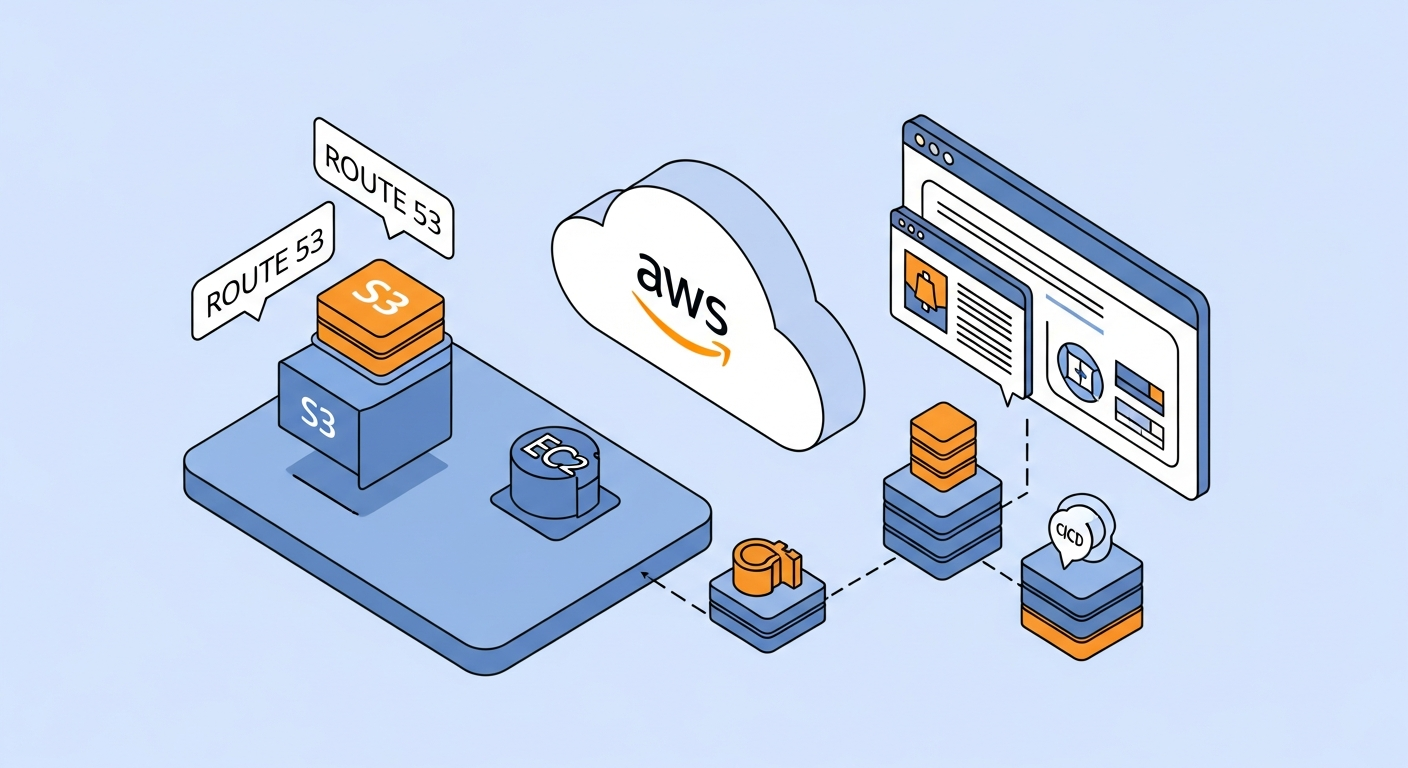Client
A newly funded startup building an online platform and needing a complete, reliable, secure, and scalable cloud environment for launch.
They had no existing infrastructure and needed an end-to-end setup covering:
-
Domain + DNS
-
Hosting
-
File storage
-
Backups
-
CI/CD deployment
-
Cloud security
-
Cost-efficient scaling
Project Overview
The client wanted to deploy their platform quickly but professionally, with a strong foundation for future growth. Their requirements included:
-
Custom domain mapping
-
AWS Route 53 DNS configuration
-
Static & dynamic hosting setup
-
S3 storage for assets, logs, and backups
-
Automated backup strategy
-
Secure & smooth CI/CD pipeline
-
A scalable architecture with monitoring
We delivered a full cloud infrastructure using AWS, ensuring the platform was production-ready from day one.
🧩 Key Challenges
1. No Existing Infrastructure
Everything had to be built from scratch — DNS, hosting, deployment, file storage, monitoring, etc.
2. Startup-Level Budget Constraints
The setup had to be cost-efficient, avoiding unnecessary heavy services while keeping scalability intact.
3. Need for Zero-Downtime Deployment
The client wanted automated deployments with no disruption to users.
4. Secure, Reliable Backups
The platform required backups for:
-
User uploads
-
Database
-
Logs
-
Config files
5. Domain Mapping Across Services
The startup needed:
-
www → main website
-
app → web application
-
api → backend services
🔧 Our Solution
We engineered a complete cloud ecosystem based on AWS services.
1. Domain Mapping with AWS Route 53
We configured all domain records including:
-
A records
-
CNAMEs
-
ALIAS records for root domain
-
Subdomains for:
-
app.domain.com
-
api.domain.com
-
cdn.domain.com (pointed to S3/CloudFront)
-
We also implemented:
-
DNS health checks
-
Failover routing supports
-
TTL optimization for faster propagation
2. Scalable Hosting Infrastructure
Depending on the client’s app type, we set up:
Option A — EC2 + Load Balancer
-
Auto Scaling Group
-
Nginx reverse proxy
-
SSL via ACM
Option B — S3 + CloudFront
-
Static hosting for landing pages
-
Global CDN distribution
-
HTTPS enforced
Option C — Containerized Deployment (ECS/ECR)
-
Docker-based build
-
ECS Fargate (serverless containers)
-
ECR for container storage
(We choose based on the client's architecture.)
3. S3 Storage Setup
We used Amazon S3 for:
-
User file uploads
-
Static assets
-
Backup storage
-
Log archiving
We also configured:
-
Lifecycle rules to move cold data to Glacier
-
Versioning to protect against accidental deletion
-
IAM roles for secure uploads
-
Bucket policies blocking public access
4. Backup & Disaster Recovery Strategy
We implemented:
✔ Database backups (RDS automated snapshots)
✔ Daily S3 incremental backups
✔ Weekly full backups stored in separate region
✔ Off-site backup option to minimize risk
✔ Cron-based backup monitoring scripts
✔ Retention policies (7-day, 30-day, 90-day)
This ensures the platform is recoverable in minutes, not hours.
5. CI/CD Deployment Pipeline
We set up a fully automated deployment workflow using:
-
GitHub Actions or GitLab CI
-
Automatic build → test → deploy
-
Zero-downtime rolling deployment
-
Integration with:
-
EC2
-
ECS
-
Lambda
-
or S3 hosting
-
Deployment Pipeline Flow:
6. Cloud Security & Permissions
We applied strong security policies:
-
IAM least-privilege roles
-
Encrypted S3 buckets
-
HTTPS everywhere
-
Security Groups by IP
-
WAF + Shield (if required)
-
Route 53 DNSSEC optional setup
7. Monitoring & Alerts
We configured:
-
CloudWatch logs
-
CPU/memory alerts
-
Uptime monitoring
-
SNS notifications for failures
-
S3 metrics for storage cost optimization
🗺 Architecture (Text Diagram)
📈 Results / Impact
🚀 Production-Ready Infrastructure in Days
The client launched quickly with a reliable professional-grade environment.
🔐 Secure & Compliant Setup
Secure DNS, backups, access control, and SSL everywhere.
👍 Zero-Downtime Deployment
New versions deployed smoothly using CI/CD.
💾 Automated Backup Pipeline
No manual backup work needed—fully scheduled & monitored.
💵 Cost-Optimized for Startups
-
S3 lifecycle rules lowered storage cost
-
Using AWS reserved/free-tier options
-
Efficient auto-scaling kept compute costs low
🌍 Scalable & Future-Proof
The setup supports:
-
Traffic spikes
-
Multiple environments
-
Global rollout

Written by
Abhi




